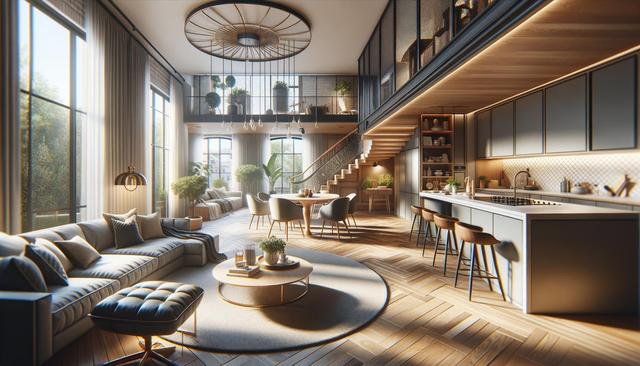Planning Your Home Upgrade
Before diving into any home upgrade project, careful planning is essential. Identifying the areas that need improvement and setting a realistic budget are the first steps. Consider creating a list of priorities based on your current lifestyle and future needs. For example, a growing family might focus on expanding living areas or adding storage, while remote workers may prioritize creating a functional home office.
Involving all household members in the planning phase ensures that the upgrades benefit everyone. Additionally, research local building codes and necessary permits, especially for structural changes or electrical work. Hiring a professional for consultations can help avoid costly mistakes and ensure your upgrades are both safe and practical.
Some common focus areas during planning include:
- Kitchen layout and appliance updates
- Bathroom functionality and aesthetics
- Lighting and energy efficiency
- Storage solutions and space optimization
By clearly defining your goals and understanding your limitations, you’ll set the foundation for a smooth and successful home improvement journey.
Energy Efficiency and Sustainability
Modern home upgrades increasingly focus on sustainability and energy efficiency. Not only do these improvements reduce your environmental impact, but they also lead to significant long-term savings on utility bills. Start by evaluating your home’s insulation, windows, and HVAC system. Poor insulation and outdated systems can lead to energy loss and uncomfortable living conditions.
Replacing old windows with energy-efficient models and sealing gaps can dramatically increase efficiency. Another effective upgrade is switching to LED lighting and smart thermostats, which allow for better control over energy use. Solar panels, although a larger investment, can eventually pay for themselves through reduced electricity costs and available tax incentives in many regions.
Other sustainability-focused upgrades may include:
- Low-flow faucets and showerheads
- Energy Star-rated appliances
- Smart irrigation systems for outdoor landscaping
Making eco-conscious choices not only benefits the planet but also enhances your home’s appeal to future buyers who value sustainability.
Enhancing Comfort and Functionality
Comfort and functionality should be at the heart of any home upgrade. This may involve rethinking layouts, adding multipurpose furniture, or incorporating technology that makes daily life more convenient. Open-concept layouts, for example, can make smaller homes feel more spacious and are great for entertaining guests.
Upgrading furniture to modular or built-in options helps maximize space, especially in smaller rooms. Smart home devices like voice-controlled assistants, automated lights, and home security systems can also improve day-to-day living. When upgrading for functionality, think about how you use each room and aim to eliminate any inefficiencies.
Practical upgrades to consider include:
- Custom closets for organized storage
- Built-in desks or shelving for small offices
- Dual-purpose furniture, such as ottomans with storage
Focusing on these elements can significantly boost your home’s usability without requiring major renovations.
Boosting Curb Appeal
The exterior of your home is just as important as the interior. Whether you’re planning to sell or simply want to enjoy your surroundings more, boosting curb appeal can make your property more inviting. Start with simple changes like repainting the front door, updating outdoor lighting, and adding seasonal plants or shrubs.
Driveway and walkway improvements, such as pressure washing or adding pavers, can also make a noticeable difference. If your budget allows, consider larger projects like updating your siding, roof, or installing a new fence. These changes not only improve aesthetics but can also increase your home’s value.
Additional ideas for enhancing curb appeal include:
- Installing window boxes with flowers or herbs
- Upgrading your mailbox and house numbers
- Refreshing porch furniture or doormats
Maintaining a clean and well-kept exterior creates a positive first impression and contributes to the overall enjoyment of your home.
Personalizing Your Living Space
One of the final touches in any home upgrade is adding your personal style. This step transforms a house into a home and makes your living spaces uniquely yours. Whether your taste leans toward modern minimalism or cozy rustic charm, incorporating elements that reflect your personality is key.
Wall colors, artwork, and decorative pieces can all be used to express your style. Consider mixing textures and materials, like wood with metal or soft fabrics with stone accents, to add depth to your interiors. Personalized upgrades don’t have to be expensive—DIY projects and thrifted items can make a big impact with a small budget.
Ideas to personalize your home include:
- Creating a gallery wall with family photos or art
- Adding indoor plants for a natural touch
- Using unique textiles like handwoven rugs or custom pillow covers
Taking the time to personalize your home ensures it feels comfortable and welcoming for you and your guests.
Conclusion: Making Home Upgrades Worthwhile
Upgrading your home is a meaningful investment that enhances both your daily life and long-term property value. By planning carefully, focusing on energy efficiency, improving functionality, enhancing curb appeal, and personalizing your space, you can create a home that truly works for your needs. Whether you’re preparing for resale or simply making your environment more enjoyable, thoughtful upgrades can have a lasting impact. Start small or go big—what matters most is that your home feels more like yours with every improvement.




Leave a Reply